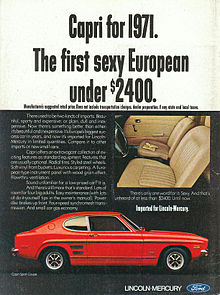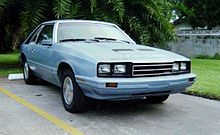- Mercury Capri
-
Mercury Capri 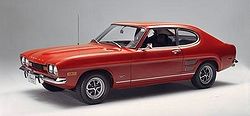
1971 Mercury CapriManufacturer Ford Motor Company Production 1970–1977
1979–1986
1991–1994Class Super Coupe (1970–1977)
Pony car (1979–1986)
Roadster (1991–1994)The Mercury Capri was marketed in North America by the Lincoln-Mercury division of the Ford Motor Company. The Mercury Capri was sold in the US as three distinctly different cars over three decades. The Capri for the 1971-74 model years and Capri II for 1976-77 were Ford captive imports made in Germany. At its peak, Capri sales in North America were the highest for any import model except the Volkswagen Beetle. These Capris, now fairly rare, are becoming sought after for restoration because of their styling, performance & relative affordability. The Capri from 1979-86 was a rebadged Ford Mustang made in the US, and from 1991–94, a convertible from Ford Australia.
Contents
History
The origin of the name after the Italian island of Capri, dates back to the Lincoln Capri of the 1950s. The European Ford Capri was developed as a "baby Mustang" for that market, a 2-door car with a short trunklid (later hatchback) and a long hood.
First generation 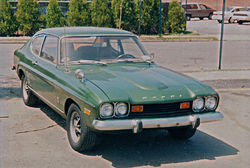
1973 Mercury Capri 2600Also called Ford Capri Production 1970–1977 Assembly Cologne, Germany
Saarlouis, Germany[1]Body style 2-door coupe (70–74)
2-door hatchback (76–78)Layout FR layout Engine 1.6 L Kent I4
2.0 L OHC I4
2.3 L OHC I4
2.6 L OHV V6
2.8 L OHV V6Related Ford Capri
Ford CortinaFirst Generation (1970–1977)
See also Ford Capri
The Mercury Capri was built in Cologne, Germany, and was sold through Lincoln-Mercury dealers in North America. The European Capri was first sold in the US in April 1970 and carried the Mercury marque identification as Ford already had a Mustang (and its twin, the Mercury Cougar) for the same buyer market. The only type initially available used the British 1600-cc Kent crossflow, with a starting price less than US$2300. The 2.0-L OHC I4 was introduced for the 1971 model year. The '71 2.0-liter Capris are particularly desirable, since they have a 9.0:1 compression ratio (which was reduced to 8.2:1 in 1972). The 2.6-L "Cologne" V6 was introduced late in the 1972 model year.
In 1973, the Capri was given a "facelift" for the model year with a revised grille, larger tail lights, and revised rear quarter "grills." North American-spec Capris received a federally mandated 5-mph front bumper. The chrome bumper was mounted in front of a steel pipe and attached to the frame by shock absorbers. The interior received revised seat trims, dashboard, and steering wheel. A new, different wiring harness was used.
North American-spec 1974 Capris adopted large, federally mandated 5-mph bumpers at both the front and rear of the car. The bumpers were covered in body-colored plastic. The 2.6-liter Cologne V6 was replaced by a 2.8-liter Cologne V6 with revised castings for both the engine block and cylinder heads.
The Capri was restyled as a hatchback in 1975, but sold in North America as an early 1976 model named the Capri II, though worldwide it was usually referred to as the Capri Mk II. Engine options were the 2.3-liter Lima 4-cylinder and the 2.8-liter Cologne V6.
After the 1977 model year, the Capri II was no longer imported from Europe. Remaining 1977 Capris were sold as 1978 models. Over a half a million German-built Capris were sold in North America 1970 through 1978. Starting in 1979, the European Capri was replaced in the North American market by the "Fox" chassis Capri. Production of the European Capri continued for the European market until 1986.
Reviews - First Generation
Road and Track magazine on the 1970 Capri 1600: "...But styling and image sells cars, right? And if that's true, then it's our opinion that Lincoln-Mercury has a real winner in the Capri."[2]
R&T on the Capri 2000 in February, 1971: "The Capri has a lot to recommend it. It's a solidly built, sporty compact car and (especially with the 2-liter engine) fun to drive."[3]
R&T on the Capri 2600 V6 in March, 1972: "...the Capri 2600 V6 is an outstanding car. We'll bet Lincoln-Mercury dealers won't be able to get enough of them to satisfy the demand."[4]
R&T on the Capri 2800 V6: "...the V6 Capri remains a very attractive sporting car. It's solid as a Mercedes, still compact and light in the context of 1974 barrier busters, fast, reasonably economical of fuel, precise-handling, and quick-stopping: its engine and drivetrain are both sporty and refined. It's no wonder Lincoln-Mercury sold nearly 120,000 of them in 1973..."[5]
R&T on the Capri II 2.8 V6: "Once again we can report that the Capri V6 is an attractive, competent, and enjoyable car at a reasonable price. It goes, stops, and handles, it's well built and it has that sturdy, precise European character that makes it something special for Americans and Canadians. On top of all this it's a more practical car because of its new hatchback body. A quality, European car at a realistic price-what more could one want."[6]
Second generation 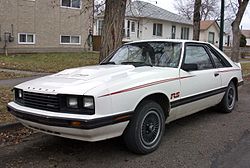
Mercury Capri RSProduction 1979–1986 Assembly Dearborn, Michigan, USA
San Jose, California, USABody style 2-door hatchback Layout FR layout Platform Ford Fox platform Engine 2.3 L OHC I4
2.3 L OHC (Turbo)
2.8 L OHV V6
3.3 L OHV I6
3.8 L OHV V6
4.2 L OHV 2-bbl. V8
5.0 HO EFI V8Transmission 4-speed O/D manual
4-speed auto
5-speed manualWheelbase 100.5 in (2,553 mm) Related Ford Mustang (79–93) Second Generation (1979–1986)
During this period, a version of the Ford Mustang was sold through Lincoln/Mercury dealers as the Mercury Capri, giving Mercury a pony car for the first time since the Mercury Cougar was upsized in 1974 to complement the Ford Thunderbird. The Capri was built on the Ford Fox platform, which was used for the Mustang from 1979 to 1993 with a design change in 1994. It was the only Mercury Capri generation with a V8 engine.
The Fox-based Mercury Capri was fairly unchanged throughout its entire run. It maintained its squared-off front fascia and grille, and distinctive flared fenders. The only major iteration happened in 1983 with the addition of a racing-inspired hatchback with a compound rear window (also known as the "bubble back"), a new rear bumper and taillights. In 1984, the high performance Capri RS received a front air dam which continued until 1986. The drivetrain and interior options closely matched that of the Mustang year for year. There are differences but they are generally minor.
Special editions
1981–83 Black Magic - Black cars with gold striping, gold metric TRX wheels and a gold cat's head on each side of the front valance. The interior received special black seats with gold inserts. The 1983 model is extremely rare and the only Black Magic to receive the compound rear window.
1981–82 White Lightning aka White Magic - This was actually the "Black Magic" version but it was allowed to be ordered in white. Dealers coined the "White Lightning" phrase from a magazine ad that Mercury ran. Mercury never used the term directly. In 1981 there were 575 "White Magic" models produced, but the rarer year was 1982 of which only 348 "White Magic" models were manufactured.
1983 Crimson Cat - Red with gold striping and Cougar XR-7 TRX wheels set this car apart. Much like the Black Magic, the Crimson Cat received custom black seats with red inserts. Only 805 Crimson Cats were made.
1984 Charcoal Turbo RS - A Capri RS Turbo that was only available in Charcoal upper / Silver lower exterior paint with Light Grey striped rub mouldings, Garret 60 trim turbocharger, enhanced multiport EFI 4-cylinder engine, Michelin TRX package, 5.0 HO Sway bars, 3.45:1 limited slip rear axle, hood scoop, and orange and red lettering and striping. Sun and T Top roof were optional.
1984–86 ASC McLaren Coupes and Convertibles - ASC (American Sunroof Corporation, now known as American Specialty Cars) converted Capris into convertibles and enhanced standard hatchbacks which they renamed "Coupes". The Coupes were tuned and enhanced with a number of suspension and visual upgrades including striping, a built-in radar detector, ground effects, Hella fog lights, headlight and taillight covers and honey comb wheels imported from Campagnolo in Italy. 1984 Coupes (25 produced) were all painted midnight blue. 1985-1986 Coupes (150 produced in 1985) were either painted blue or white. In 1986 (115 made), the last year for the Coupes, customers had an even larger choice of colors, including Smoke Charcoal Grey & Raven Black, joining the Oxford White and Midnight Blue, as well as Silver Metallic. http://www.ascmclaren.com/capripics.htm
Coupes were equipped with the Ford Motorsport B303 camshaft,[citation needed] creating significantly more power than the rated 200/210BHP of the standard 5.0 motors. Additionally, all coupes were shod with BF Goodrich Comp T/A radials. The 225/50/15 low profile size of these tires (as opposed to the standard 5.0L Capri's 225/60/15) raised the ASC/McLaren Coupe's effective gear ratio from 3.08:1 to approximately 3.35:1. These were the quickest cars produced by Ford in 1985 & 1986 with zero to sixty times well under six seconds and quarter mile times in the mid-13 second range.
The convertibles were a far more involved project. This required the redesigning of the car's unit construction and the fabrication of a replacement rear deck lid, floor reinforcements, quarter panel caps, tonneau cover and a windshield that was raked back an extra 10 degrees. They received a manual convertible top that took up residence in the area once designated for the rear seats. The ascMcLaren convertibles use a smaller top than the Mustang convertible that is unique to that car, as are the seals, weatherstripping, windshield moldings, etc.
1985 Mercury Motorsport Capri - Grand Prix IV Pace Car - 30 were built in 1985 as pace cars replicas to commemorate the fourth year of the Detroit Grand Prix. These were also modified by ASC McLaren for Mercury and are highly sought after for their racing heritage. Over two-thirds are accounted for.
Third generation 
Mercury Capri ConvertibleProduction 1989–1994 Assembly Campbellfield, Victoria, Australia Body style 2-door roadster Layout FF layout Engine 1.6 L B6-2E I4
1.6 L Turbo B6T I4Transmission 4-speed automatic
5-speed manualWheelbase 94.7 in (2,405 mm) Length 1993–94: 167.1 in (4,244 mm)
1991–92: 166.1 in (4,219 mm)Width 64.6 in (1,641 mm) Height 1991–92: 50.2 in (1,275 mm)
1993–94 Base: 50.4 in (1,280 mm)
1993–94 XR2: 49.9 in (1,267 mm)Related Mazda 323 Third Generation (1991–1994)
Ford Australia produced a Mazda Miata rival named the Ford Capri from 1989, which was ironically based around many Mazda 323 mechanics. Therefore, it is Front Wheel Drive as opposed to the Mazda Miata's Rear Wheel Drive. From the 1991 model year, this car was sold in North America as the Mercury Capri. The car was sold until the 1994 model year with minimal changes (1994 models did get a minor cosmetic update that included new front and rear bumpers as well as taillights). The XR2 also came standard with an independent rear suspension, and offering reinforced front and rear sway bars.
Despite mechanical issues with the Capri in the United States, the Australian version was a reliable vehicle. Many are still in use as "daily drivers" in Australia, with the only faults being reported relating to leaks in the roof.[citation needed] In the United States, the car was known to have had electrical problems (the heater core is located on the right side interior firewall above the main computer, so wrapping the electronics here with water tight plastic shielding is advised) as well as drivetrain problems related to cold and/or extreme weather operation.[citation needed]
Ford sought to import the Australian convertible in response to Madza's Miata, necessitating the addition of a driver's airbag for the US market. The Capri featured four usable seats, a lockable top storage and lockable fold down back seat that made the trunk accessible through the interior when the soft top is up. Popular options included a removable hard top.[citation needed]
Two versions were offered for all model years: base and XR2. The base model featured a Mazda 1.6L DOHC 4-cylinder rated at 100 hp. The XR2 featured a turbocharged version of 1.6L engine rated at 132 hp. Both the base model and the XR2 had a 5-speed manual transmission standard; a 4-speed automatic was optional only for the base model.
Gallery
1976 Capri IICapri RSCapri RSCapri ConvertibleSee also
References
External links
- MercuryCapri.Com
- 1985 Motorsport Capri Registry
- Fox Capri Literature - A resource for 79-86 Capri information. (brochures, dealer fact books, salesman guides, upholstery books, advertisements, etc.)
- ascMcLaren Registry and Owner Forums - A user's group devoted to the 84-90 Capri and Mustang Fox based ascMcLaren cars.
- FourEyedPride.Com - The largest resource for both 79-86 Fox Chassis Mustangs and Capris.
Mercury, a division of Ford Motor Company, 1939–2011 Category · VehiclesFinal models
(2010-2011)Historic models Bobcat · Brougham · Capri · Colony Park · Comet · Commuter · Custom · Cougar · Cyclone · Eight · LN7 · Lynx · M-Series · Marauder · Marquis · Medalist · Meteor · Monarch · Montclair · Montego · Monterey (car) · Monterey (mini-van) · Mystique · Park Lane Brougham · S-55 · Sable · Topaz · Tracer · Turnpike Cruiser · Villager · Voyager · ZephyrConcept cars Mercury passenger vehicle timeline, 1950–1989 — next » Type 1950s 1960s 1970s 1980s 0 1 2 3 4 5 6 7 8 9 0 1 2 3 4 5 6 7 8 9 0 1 2 3 4 5 6 7 8 9 0 1 2 3 4 5 6 7 8 9 Subcompact Bobcat Lynx Tracer Compact Comet Comet Comet Zephyr Topaz Topaz Monarch Mid-size Meteor Montego Cougar Cougar Marquis Comet Comet Sable Full-size Eight Montclair Meteor Montclair Monterey Monterey Monterey Monterey Monterey Monterey Park Lane Park Lane Marquis Marquis Marquis Grand Marquis Brougham Turnpike Cruiser S-55 S-55 Marauder Marauder C. Park Colony Park Colony Park Colony Park Colony Park Colony Park Commuter Commuter Commuter Voyager Sports car Capri Capri Cougar Cougar LN7 Personal Cougar Cougar Cougar Cougar Cougar « previous – Mercury passenger vehicle timeline, 1980–2011 Type 1980s 1990s 2000s 2010s 0 1 2 3 4 5 6 7 8 9 0 1 2 3 4 5 6 7 8 9 0 1 2 3 4 5 6 7 8 9 0 1 Subcompact Bobcat Lynx Tracer Compact Tracer Tracer Zephyr Topaz Topaz Mystique Mid-size Monarch Marquis Sable Sable Sable Sable Milan Full-size Marquis Grand Marquis Grand Marquis Grand Marquis Grand Marquis Colony Park Marauder Montego Sable Sport compact Capri Capri LN7 Cougar Personal Cougar Cougar Cougar SUV Mariner Mariner Mountaineer Mountaineer Mountaineer Minivan Villager Villager Monterey Categories:- Mercury vehicles
- Rear wheel drive vehicles
- Front wheel drive vehicles
- Sports cars
- Roadsters
- Convertibles
- Coupes
- Hatchbacks
- 1970s automobiles
- 1980s automobiles
- 1990s automobiles
- Vehicles introduced in 1969
Wikimedia Foundation. 2010.


